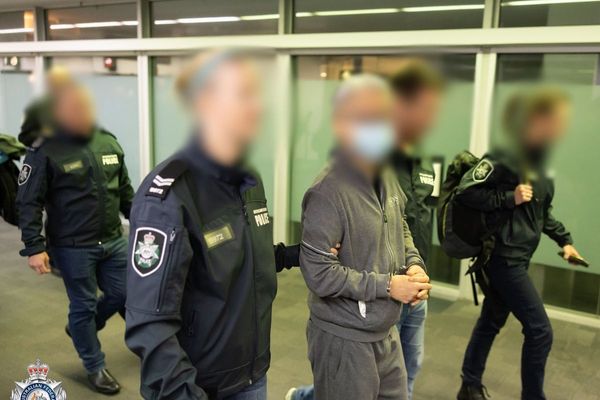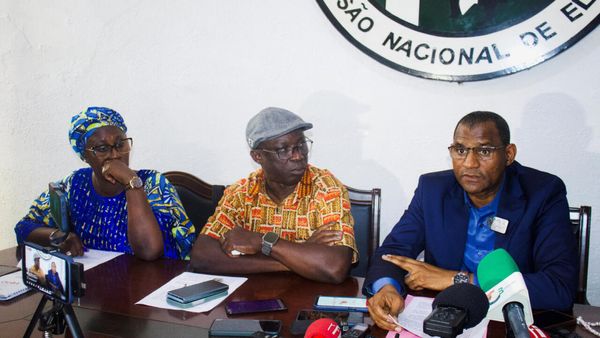

Lawyers are looking into whether former Greens candidate Hannah Thomas could sue police over alleged excessive use of force at a protest in Belmore, amid ongoing questions around the police’s response and “draconian” protest laws in NSW.
With five people charged, and at least one person seriously injured, there’s been legitimate concerns raised in the last few days when it comes to the lawfulness of the police response.
What happened in Belmore?
Last Friday, a pro-Palestinian protest gathered outside a manufacturing facility in Sydney’s south-west. The protesters allege the facility, SEC Plating, supplies plating for the F-35 jets used by the Israeli Defence Force, an allegation the company denies.
The protest was broken up by NSW Police, during which several protesters sustained injuries. Thomas herself sustained serious injuries, undergoing surgery at Bankstown Hospital. She’s said she may permanently lose vision in her right eye.
The exact nature of the clash between protesters and police — and what right cops had to use the force they did — is under question.

NSW Police claims the protest was “unauthorised” and officers issued a move-on direction to “a group of about 60 protestors” after they allegedly attempted to block access into the business.
However, the protesters claim it was a peaceful gathering, and was held at around 5:30am, nearly two hours before the business even opened. Protesters claim subsequent footage of the incident also shows the police officers failing to explain what laws they were evoking to break up the assembly.
Thomas has been charged with resisting police and refusing or failing to comply with a direction to disperse. Four others were also charged with a range of offences.
What has the response been?
The fall out from the protest and police response has been dramatic and is ongoing.
On Monday, NSW Greens MP Sue Higginson wrote to Premier Chris Minns demanding urgent action, including that all charges laid against protesters be withdrawn, and that NSW Police declare a critical incident.
“What occurred in Belmore was not policing — it was punishment. A member of our community was brutally assaulted by uniformed officers while engaging in peaceful political expression,” she wrote.
“This has happened in a state where you and your government have continuously expressed intolerance for protest and emboldened police to suppress protest through arbitrary, dangerous laws and sweeping police powers.”
A critical incident has now been declared, which is when an event involving an NSW Police officer results in the death or a serious injury of a person. It means an investigation will now be undertaken into the events that unfolded around Thomas’ arrest.

Peter O’Brien, a principal solicitor for O’Brien Criminal and Civil Solicitors who is representing the people arrested, said he had “grave concerns” over what happened at the protest, and claimed recordings and footage demonstrate a “fundamental misunderstanding” of police powers.
“The government was warned that these changes to expand police powers to disperse protestors could lead to serious and ugly confrontations,” he said in a statement.
The police powers he’s referring to are new laws passed in the NSW parliament in February, which allow police to issue move-on orders if a protest is taking place near a place of worship.
What are the new police powers?
Protest organisers can apply for what’s called a Notice of Intention to Hold a Public Assembly — which isn’t mandatory, but can protect protesters from being charged if accepted by police.
For other protests that have not applied for this, a separate Law Enforcement Powers and Responsibilities Act (LEPRA) allows police to issue a move-on order if a person poses a “serious risk” to someone’s safety, or if they’re obstructing traffic.
Earlier this year, controversial anti-protest laws passed in the NSW parliament expanded these powers, authorising a police officer to issue a move-on direction to a person who is participating in a demonstration, protest, procession or assembly occurring in or near a place of worship. (The laws were part of a slew of reforms to curb antisemitism in the state, after a series of vandalism and arson attacks last year.)
The protest does not have to be about religion, or directed at the place of worship, to apply. Plus, the definition of “near” is left to the police’s discretion, with the Human Rights Law Centre noting the language used “is ill-defined and broad”.
As reported by the Sydney Morning Herald, a police factsheet for one of the protesters, age 29, cited a “place of worship” in a document describing the arrest.
The SEC Plating business on Lakemba Street is across from the Teebah Islamic Association Mosque.

Per the publication, new footage of the incident also shows police informing protesters they were being given a move-on order, although further details were not provided in those videos.
At one point, an activist asked police to cite the legislation behind the move-on order, noting it is “actually counter to LEPRA [the Law Enforcement Powers and Responsibilities Act]”. A male officer, in response, pulled the man away.
However, NSW Police Assistant Commissioner Brett McFadden said none of the five protesters charged were issued with offences under the new legislation.
Premier Chris Minns also told reporters on Monday that police relied on previously existing powers, per The Guardian.
In her letter to the Premier, the Greens’ Higginson has taken aim at the police response to direct protesters to leave the area at Belmore, noting there are certain conditions to be met before a move-on order becomes lawful. There are also limits on situations when even that lawful order can be issued.
“The move-on power of police in NSW cannot be exercised lawfully where people who are subject to that order are engaged in genuine protest or demonstration. The power to move on genuine protests can only be made if traffic is being blocked, there is a genuine safety risk, or if the protest is near a place of worship,” she told PEDESTRIAN.TV.
Plus, there’s the matter of the protest being described as “unauthorised”, with Higginson remarking there’s “no such thing as an authorised protest”.
“The concept of an ‘unauthorised’ protest as the police have been promoting is just a protest — something that is absolutely legal. There is a process that members of the community can go through in order to protect themselves from being issued fines for blocking traffic or other offences, but a protest does not become ‘unauthorised’ just because that process isn’t used,” she said.
She has called for the state’s “poorly drafted” anti-protest laws to be repealed.
The laws are focused more as punitive actions against protesters than protecting the public, she told P.TV.
“When we join the dots, it’s so clear that the last tranche of anti-protest laws were a slide too far into a police state — a protest took place, police responded with violence and now references to those laws are flying around in police fact sheets,” Higginson said.

Michael Bradley, managing partner at Marque Lawyers, told P.TV. there have been many confusing statements made by police around the matter, with a lot of emerging, seemingly “inconsistent” evidence.
“It’s difficult to know what happened, but it seems the police appear to have thought that they have some kind of general power to make people move on on little or no basis at all,” he remarked.
“I mean, it’s hard to know what [the protesters] were doing wrong. They were congregated outside a commercial premises, before dawn, and the police rocked up and told them that they had all had to leave and were allowed back in that suburb for 24 hours. They seemed to have said various things to various protesters as to the basis on which they were making that move-on order.”
Bradley agreed there are valid questions about whether the lawfulness of the response, and if the level of force used was necessary.
“[The questions are] in the context of a continuous campaign by state governments to restrict legitimate protest activity. And the New South Wales government’s made it clear that they think protest, per se, should be illegal, at least particularly when it’s anything to do with Palestine.”
Bradley remarked it was “understandable” the police were unsure of the extent of their powers, given changing laws and pressures to prevent peaceful protest activity.
But the protesters at Belmore weren’t blocking traffic or putting anyone at risk, and there’s no suggestion the assembly was violent before the police arrived, he pointed out.
“It’s pretty clear that [Thomas] suffered an extremely serious injury. From the footage I’ve seen, that appears to have occurred during her arrest. It’s hard to imagine why it was necessary to use a degree of force on her in that context, such that the risk of that severity of injury could be present. And even if she was resisting, which she certainly denies, who was in danger?”
What happens next?
With a critical incident declared, there will be a probe into Thomas’ arrest, led by a team attached to the Campbelltown City Police Area Command.
Addressing the media on Monday, NSW Police’s McFadden said police would look into the “full circumstances” of the injury. However, he stopped short of any further comments into the details of her arrest.
“It is unfortunate that any person gets injured, and we take the nature and assessment of those injuries quite seriously,” he said, per the Sydney Morning Herald.
The investigation will be reviewed by the Professional Standards Command, with oversight from the Law Enforcement Conduct Commission (LECC).
The LECC confirmed it will be monitoring the NSW Police Force’s investigation in real time, and once finalised, it will provide advice on whether this was fully and properly conducted.
Meanwhile, the five people charged following the Belmore protest have all been granted conditional bail. They are due to appear at Bankstown Local Court on July 15.
The post Belmore Protest & Hannah Thomas’ Arrest: Was The Police Response Lawful? appeared first on PEDESTRIAN.TV .







